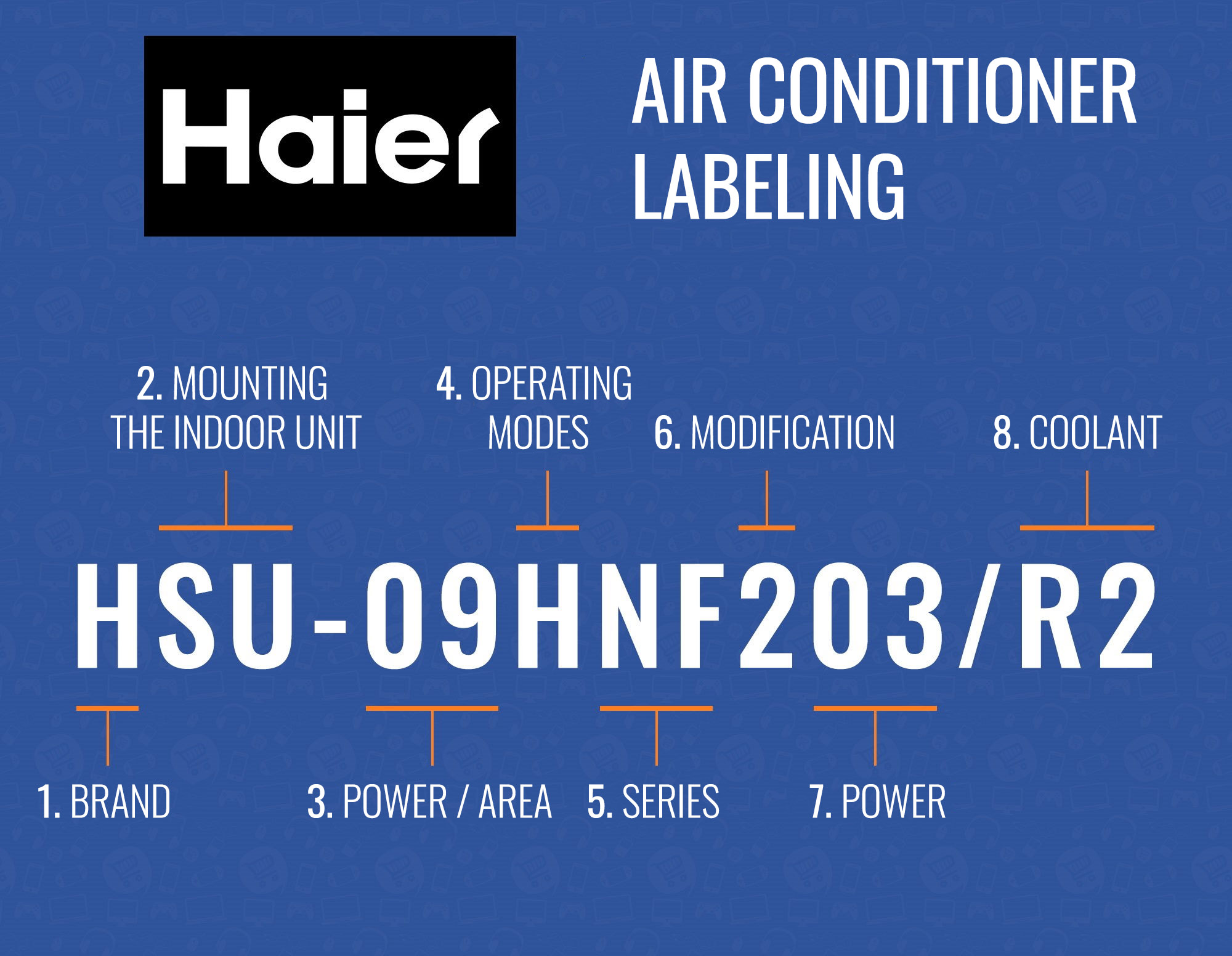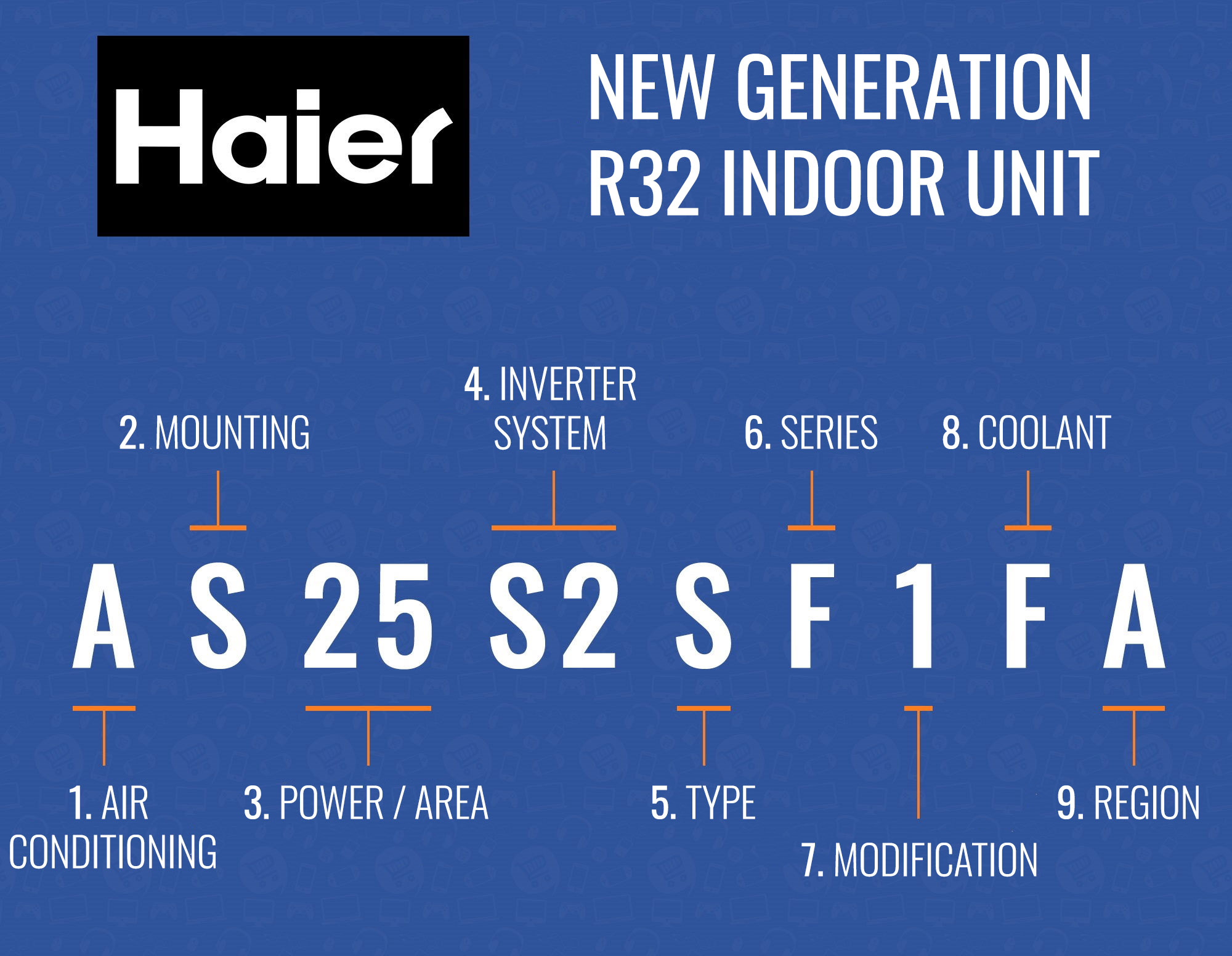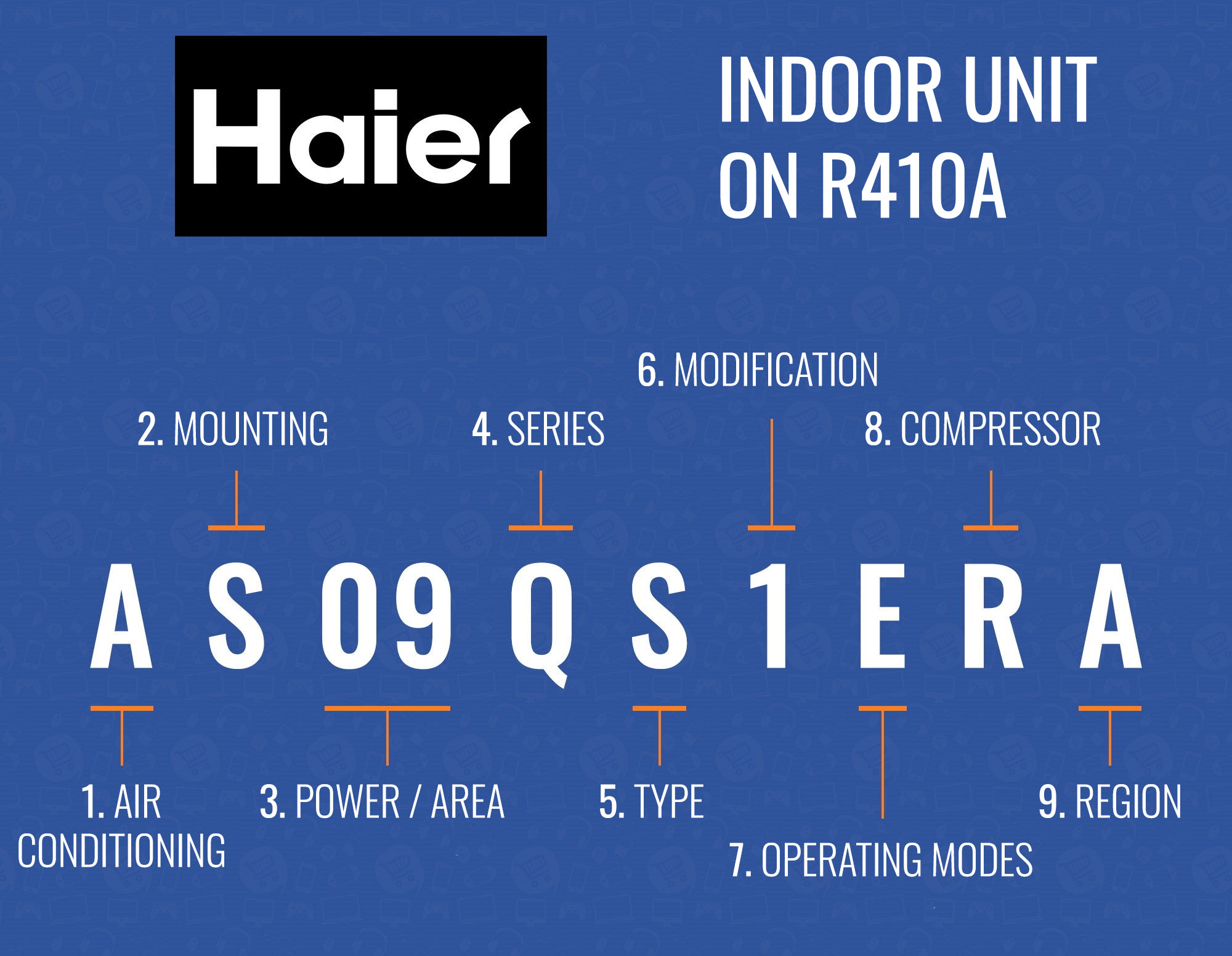Deciphering the labeling of Haier air conditioners

Below we will take a detailed look at the most popular options for labeling Haier air conditioners.
Consider an example on the marking HSU-09HNF203/R2
 |
1. This is the designation of the Haier brand itself, there will always be an H in this type of marking.
2. Designation of the type of installation of the split system indoor unit, acceptable values:
- SU — wall-mounted indoor unit;
- BU — cassette-type ceiling indoor unit;
- PU — outdoor column-type indoor unit;
- CFU — universal floor-and-ceiling indoor unit;
- DU is a hidden channel—type indoor unit.
3. The indicator of the power of the air conditioner in BTU, an example of decoding:
- 07 — 7000 BTU, air conditioning is designed for an area of ~ 20 — 22 m2;
- 09 — 9000 BTU, air conditioning is designed for an area of ~ 25 — 27 m2;
- 12 — 12000 BTU, the air conditioner is designed for an area of ~ 32 — 37 m2;
- 18 — 18000 BTU, the air conditioner is designed for an area of ~ 45 — 55 m2;
- 24 — 24000 BTU, the air conditioner is designed for an area of ~ 65 — 75 m2.
4. In this place there is a letter that speaks about the operating modes of the air conditioner, acceptable values:
- H — the air conditioner works for cooling and heating;
- R — the air conditioner works for cooling and heating;
- C — the air conditioner works only for cooling;
- L — The air conditioner works only for cooling;
5. In this place, usually, there is a combination of one or two letters responsible for belonging to the series, examples of values:
- HT — Tibio Series;
- HF — Lightera Series on/off;
- LT — series Leader.
6. Here is the number responsible for the modification of the series, acceptable values:
- – there may not be any number, this implies that the model of this line is the first and has no modifications;
- 1, 2, 3 — modification number, usually occur from 1 to 3, but other values are possible in the future.
7. The digits 03 mean single-phase connection, this figure refers to household.
8. R+digit, means the type of refrigerant used, the following values occur:
- R1 — does not have an exact definition, the refrigerant can be R22, R407C, R410A;
- R2 — used refrigerant R410A;
- R3 — refrigerant R32, more modern models.
New generation R32 indoor unit — AS25S2SF1FA
 |
Indoor unit on R410A — AS09QS1ERA
 |
Consider an example of the second type of marking, there are also two AS25S2SF1FA /1U25S2SM1FA, as you can see, there is a marking of the internal and external block. Another subtype of AS09QS1ERA markings, in this case only the indoor unit, these markings differ mainly in the principle of indicating power, they are more or less similar, let's consider them together.
1. A is an abbreviation of the English Aircon or the full name of Air Conditionig, in our case this letter will always be.
2. The second letter means the type of indoor unit or outdoor unit, acceptable values:
- S — wall-mounted indoor unit;
- B — cassette type ceiling indoor unit;
- C — universal floor-sub-floor indoor unit;
- D — hidden channel-type indoor unit;
- E — hidden channel-type indoor unit with floor placement;
- P — outdoor column-type indoor unit;
- F — outdoor indoor unit;
- U, V are the designations of the outdoor unit.
3. There can be two types of numbers in this place, depending on the generation of the model, the first type is similar to the previous marking in BTU, and the second is the estimated area of application in m2, in another way, the rated power multiplied by 10. Let's look at the examples:
- 25 means the recommended area of use is 25 m2, and the rated power of the air conditioner is 25 x 10 = 2500 watts;
- 35 means the recommended area of use is 35 m2, and the rated power of the air conditioner is 35 x 10 = 3500 W;
- 50 means the recommended area of use is 50 m2, and the rated power of the air conditioner is 50 x 10 = 5000 watts;
- 71 means the recommended area of use is 71 m2, and the rated power of the air conditioner is 71 x 10 = 7100 watts.
It is worth noting that these figures are indicative, their task is to make it clear approximately what area they are designed for, looking at the article itself, in reality, the power indicators are slightly different, it is also worth considering that the power for heating is usually higher than for cooling.
4. In this place there may be one letter that can mean belonging to the series, in models with refrigerant R410A, in models R32 of the new generation, there is usually a combination of S2, which means belonging to inverter split systems such as SuperMatch 2.
For models with refrigerant R410A:
- Q — Aqua Series;
- C — series Lightera Crystal.
For new models with R32:
- S2 is an inverter split system of the SuperMatch 2 type (see below).
5. Type of combination of indoor units, acceptable values:
- A — split system;
- S — Super Match, assumes the compatibility of indoor and outdoor units of various capacities and layouts;
- M is a multi—split system.
6. For R32 models, there is a letter in this place indicating which series the model belongs to, in this case the F — series Flexis. For the rest, here is a number meaning modification, 1,2 3, etc.
7. For the R32 model in the first example, this means generations, here will be the number 1, 2, 3. For the second model, here is the letter responsible for the operating mode:
- E — operation in cooling and heating mode for models with refrigerant R410A;
- Q — cooling only, models with R410A;
- H — operation in cooling and heating mode for models with refrigerant R32.
8. For marking the first example, the type of refrigerant F — R32 is indicated here, so far there are no others for this subtype. For the second example, the letter means the type of compressor:
- A — G is a conventional, non—inverter compressor;
- H — Q — AC inverter, converts current from AC to DC and back to AC;
- The R — Z — DC inverter converts the current once from AC to DC.
DC inverters have a number of advantages, including improved efficiency, protection against voltage surges, reduced noise level and others.
9. The last letter means the region of delivery to a certain market, in our case there will almost always be the letter A at the end, for semi-industrial there is also the letter B, meaning that this is a model for a certain market in three-phase execution.
An example of decryption for an external block is 1U25S2SM1FA
 |
1. This figure means the type of outdoor unit, 1 for split systems, 2 for multi—split systems.
2. The letter means the type of block, in this case U is an external block.
3. The area for which the air conditioner is designed is calculated in the same way as for the indoor units discussed above.
4. S2 belonging to the type of so-called super-readable split systems such as Super Match 2.
5. S — means that it belongs to the general Super Match family.
6. The letter means the standard size of the case, some of them will be considered below:
- M — size 800x553x275;
- J — size 910x390x619;
- R — size 898x340x697;
- C — size 780x270x540;
- F — size 810x288x680;
- B — size 780x248x540.
This is part of the examples, there are actually more body types, and they change with the release of new models.
7. The digit means the modification generation.
8. FA — refrigerant R32 and single-phase connection.
Articles, reviews, useful tips
All materials















